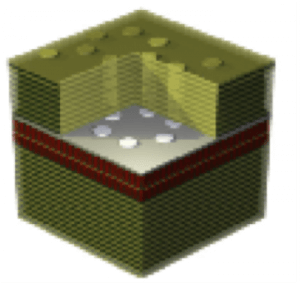Summary
In this project, we build a solid-state quantum simulator for engineering a specific Hamiltonian. Quantum simulators are purpose-built devices with little to no need for error correction, thereby making this type of hardware less demanding than universal quantum computers. Our platform consists of exciton-polariton condensates in multiple quantum-wells sandwiched in a semiconductor Bragg stack onto which a two-dimensional lattice was imprinted. The lattice imprinting can be achieved, for example, by partial etching of the spacer with the lattice pattern followed by an overgrowth of the upper layers of the Bragg structure.
We are particularly interested in exciton-polariton condensates in a kagome lattice, where we can identify topological properties as a function of particle density. A standard optical technique allows us to quantify wavefunctions of exciton-polaritons. To do this, we construct an interferometer for measurement and use power-dependent photoluminescence to identify quantum phases in the kagome lattice.
Our goal is to advance the measurement of topological parameters and knowledge of condensed matter physics in engineered exciton-polariton simulators. This will serve to elucidate quantum phases in a controlled manner and bring us closer to a quantum simulator capable of delivering meaningful insights into quantum materials and optimization.

Figure 1. (top) A hexagonal lattice of micro-cavities formed in a Bragg stack structure with a spacer (white layer) sandwiching multiple quantum wells (red layers). (bottom) Bandstructures of exciton-polaritons in a two-dimensional kagome lattice. As the pump power changes, exciton-polaritons undergo phase transition to form coherent states: below threshold (a) P/Pth ~ 0.04, near threshold (b) P/Pth ~ 1, and above threshold (c) P/Pth ~ 2, where Pth is the threshold pump power.
Related Content

Extensible Technology for a Medium-Scale Superconducting Quantum Processor
Summary Superconducting quantum bits, or qubits, use circuits made from superconducting materials to harness quantum mechanical states. These devices contain many atoms, but can behave as simple, controllable qubits. We are building technologies for the control and measurement of superconducting qubits to enable the first demonstration of an extensible, medium-scale quantum processor. Our approach […]
November 28, 2016

Engineering and Characterizing Programmable Interaction Graphs in a Trapped Ion Quantum Simulator
Summary Quantum simulators have the potential to bring unprecedented capabilities in areas such as the discovery of new materials and drugs. Engineering precise and programmable interaction graphs between qubits or spins forms the backbone of simulator applications. The trapped ion system is unique in that the interaction graph between qubits can be programmed, in […]
July 24, 2018

Quantum Light Sources Based on Deterministic Photon Subtraction
Summary This project develops new sources of light that utilize quantum entanglement to enhance imaging resolution and detection. We aim to go beyond simple photon pairs and advance our understanding and control of new quantum states of light. Our approach uses deterministic single-photon subtraction (removing of a specific photon from a pulse of light) […]
July 13, 2018
Implementing High-fidelity Quantum Gates in Multi-level Trapped Ions
Summary The scalability of quantum processors is limited by current error rates for single-qubit gates. By encoding more than a single bit of information within a single ion, multi-level “qudits” offer a promising method of increasing the information density within a quantum processor, and therefore minimizing the number of gates and associated error rates. […]
July 30, 2018


